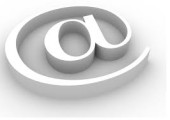I got several e-mails and text messages yesterday from other professionals and colleagues that contained one or more emoticons – you know, those little symbols of smiley faces or their derivatives made out of punctuation marks. These have become more popular with the advent of phone texting and Twitter, platforms of communication which limit the character count of a message. They are safe little familiar symbols that can be used in informal, personal communication to convey mood, or indicate that the preceding message isn’t serious. But one of the messages I received was acting in a different role, that of a selling communication piece, and I felt it was inappropriate to include this little symbol in this message. It reduced the seriousness of the document, as it was intended, but it also reduced the credibility of the sender, and diluted the sales message to the point that no serious prospect would consider buying services from this company – a net loss just for using a little symbol.
That shows the power that written communication still has to hold, engage and persuade us in today’s high-speed communications environment. It also shows how much impact a few characters can have, be it negative or positive. Written communication is one of the elements that separates Man (big M) from other animals, and as such, I feel it’s owed a certain level of respect and that each of us should practice it’s usage and strive for the highest level of clarity and effectiveness in all of our written communication efforts, no matter how trivial or insignificant it’s intent. These little symbols work against that principal, and as such have no place in professional communications.
Language is a very powerful tool, and written language has the additional advantages of thoughtfulness and permanence. You can take your time, craft effective phrases, get the word choice exactly correct to convey slight shades of meaning, and one you write it, either on paper or on a screen, you can review it again and again, in different contexts and under different circumstances, to help digest and grasp the intended meanings over time.
Professionals, like the consultants here at Granite Partners, spend hours and hours honing their writing skills, crafting effective copy that evokes an emotional response from the reader, one that can persuade the reader to take action, either in advertising, or in direct mail, to make a purchase, to send back a coupon, to answer a survey, to buy an ad, and a host of other activities, without using one of these little symbols. We spend days devising questions to elicit a usable response in surveys, either to be spoken or read by the respondent, and don’t use any of those little symbols. We spend hours on the wording for a headline that elicits just the right emotional response, days on a piece of collateral material, fact checking, spell checking, organizing and editing to elicit just the correct reaction to the offer and call to action – without using any of those little symbols. So why are they even here?
People use them as a short cut. They are lazy, or not properly motivated or sufficiently educated to use their own language properly, so the symbols make it easier to convey emotion with a limited vocabulary. It may seem curmudgeonly to professional readers, but I feel that anyone who has graduated with a diploma from a public high school paid for by tax-payers in the country should be able to craft a sentence that is adequately robust so as to not need to add an emoticon at the end to convey meaning. Maybe a little test about a week before graduation for every senior, one that asks each one to write five paragraphs that will be sufficiently eloquent to persuade the principal that they should be allowed to graduate, without using the little symbols. I wonder what that would do to summer-school enrollment . . . ?
More about the craft of language and other fascinating topics in your copy of “The Marketing Doctor’s Survival Notes”




